
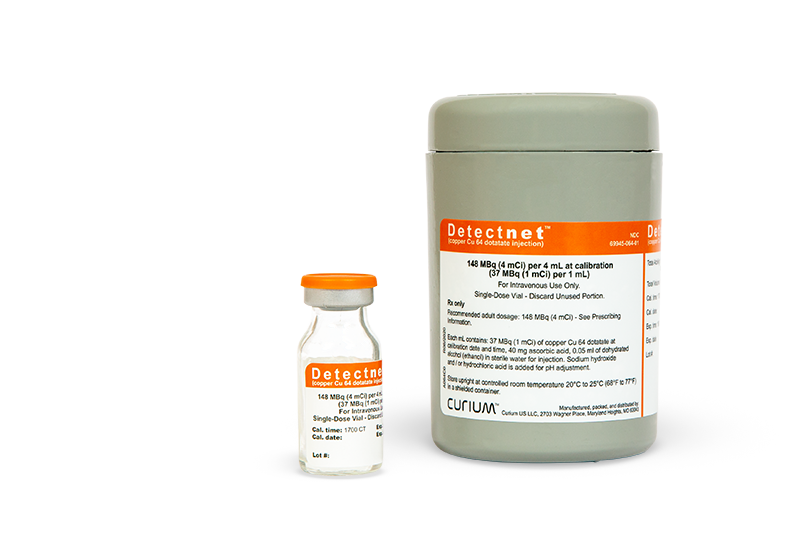
U.S. PET PRODUCTS | ONCOLOGY
Detectnet™
(copper Cu 64 dotatate injection)
This information is intended for U.S. healthcare professionals only.
Product information
Detectnet combines accuracy and access for timely NET detection, diagnosis and treatment1,2
See how 64Cu’s short positron range plays a role in high-accuracy imaging here.
64Cu has a shorter positron range than most other isotopes which allows for better detection of small lesions, including those that are close in proximity.3-5 This is important when imaging neuroendocrine tumors (NETs) since the majority of patients with NETs present with metastases, which can be small and may arise in any part of the body.6-8
IMPORTANT RISK INFORMATION
WARNINGS AND PRECAUTIONS
Risk for Image Misinterpretation
The uptake of copper Cu 64 dotatate reflects the level of somatostatin receptor density in NETs, however, uptake can also be seen in a variety of other tumors that also express somatostatin receptors. Increased uptake might also be seen in other non-cancerous pathologic conditions that express somatostatin receptors including thyroid disease or in subacute inflammation, or might occur as a normal physiologic variant (e.g., uncinate process of the pancreas).
A negative scan after the administration of Detectnet in patients who do not have a history of NET disease does not rule out disease.
Clinical studies support efficacy
The efficacy and accuracy of Detectnet were evaluated in multiple studies.1,2,8
Detectnet consistently yields high-quality images that help you accurately diagnose your patients.1,2
Detectnet enables you to target only the regions that require treatment1,2,8
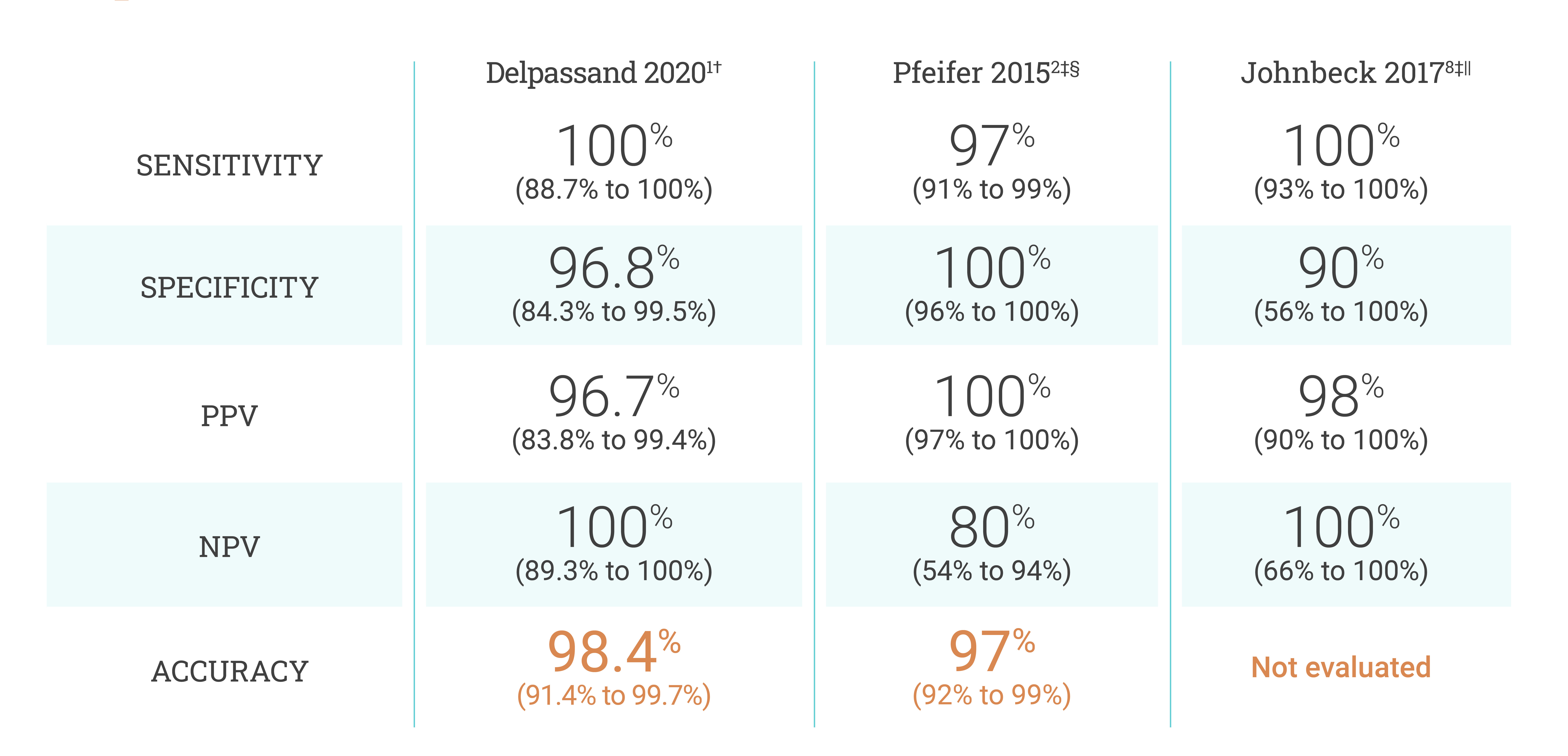
‡These studies did not include a histopathological standard of truth (SOT).
Confidence intervals are in parentheses.
Abbreviations: NPV, negative predictive value; PPV, positive predictive value.
• In Delpassand 2020, the phase 3 pivotal study, Detectnet produced high-quality images with a high rate of accuracy to confirm or exclude presence of disease1
• Pfeifer 2015 showed similar diagnostic performance to Delpassand 20201,2
• Johnbeck 2017 supports the high diagnostic performance of copper Cu 64 dotatate8
†Delpassand 2020 study design1
A phase 3, open-label, single-dose, single-arm, single-center prospective study to evaluate the sensitivity and specificity of Detectnet PET/computed tomography (CT) imaging in 63 subjects (42 with known or suspected NETs and 21 healthy volunteers) against an independent reader’s SOT for each subject. PET/CT scans were taken ~60 minutes after a single IV dose of 148 MBq ± 10% of Detectnet. A limitation was 3 mistaken SOT determinations, but these were revised. The SOT reads for 3 subjects were incorrectly recorded as NET positive instead of NET negative. Because the objective of the study was to assess the performance of the PET/CT scan and not the SOT, the corrected values are shown.
§Pfeifer 2015 study design2,9
An open-label, single-center, single-dose, comparative study of 112 patients using copper Cu 64 dotatate to assess diagnostic performance vs the standard of care single-photon emission computerized tomography (SPECT) product in patients with confirmed gastroenteropancreatic or pulmonary NETs. PET scans were acquired 1 hour after injection of 202 MBq of copper Cu 64 dotatate after diagnostic contrast-enhanced CT scan. Detectnet is FDA-approved for a dose of 148 MBq. This study was designed to evaluate routine implementation of copper Cu 64 dotatate, not as an assessment of superiority.
IMPORTANT RISK INFORMATION
WARNINGS AND PRECAUTIONS
Hypersensitivity Reactions
Hypersensitivity reactions following administration of somatostatin receptor imaging agents predominantly consisted of cutaneous reactions such as rash and pruritus. Reactions reversed either spontaneously or with routine symptomatic management. Less frequently hypersensitivity reactions included angioedema or cases with features of anaphylaxis.
A head-to-head study was performed with gallium Ga 68 dotatoc8¶
Johnbeck 2017 study design8,9
A prospective, open-label, single-center, European head-to-head study compared the diagnostic performance of copper Cu 64 dotatate PET/CT with gallium Ga 68 dotatoc PET/CT. Patients (n=59) with a history of NETs were scanned with both copper Cu 64 dotatate and gallium Ga 68 dotatoc PET/CT within 1 week of each other. A 200-MBq injection of copper Cu 64 dotatate was administered intravenously, and PET/CT was performed after 60 minutes. A 150-MBq injection of gallium Ga 68 dotatoc was administered intravenously, and PET/CT was performed after 45 minutes. A limitation was the acquisition of a diagnostic CT scan with only copper Cu 64 dotatate PET; however, the lesion-to-lesion comparison in the study mitigated this concern. Detectnet is FDA-approved for a dose of 148 MBq.
¶This trial was not designed as a superiority study. Clinical follow-up was at least 30 months.
Lesion detection8
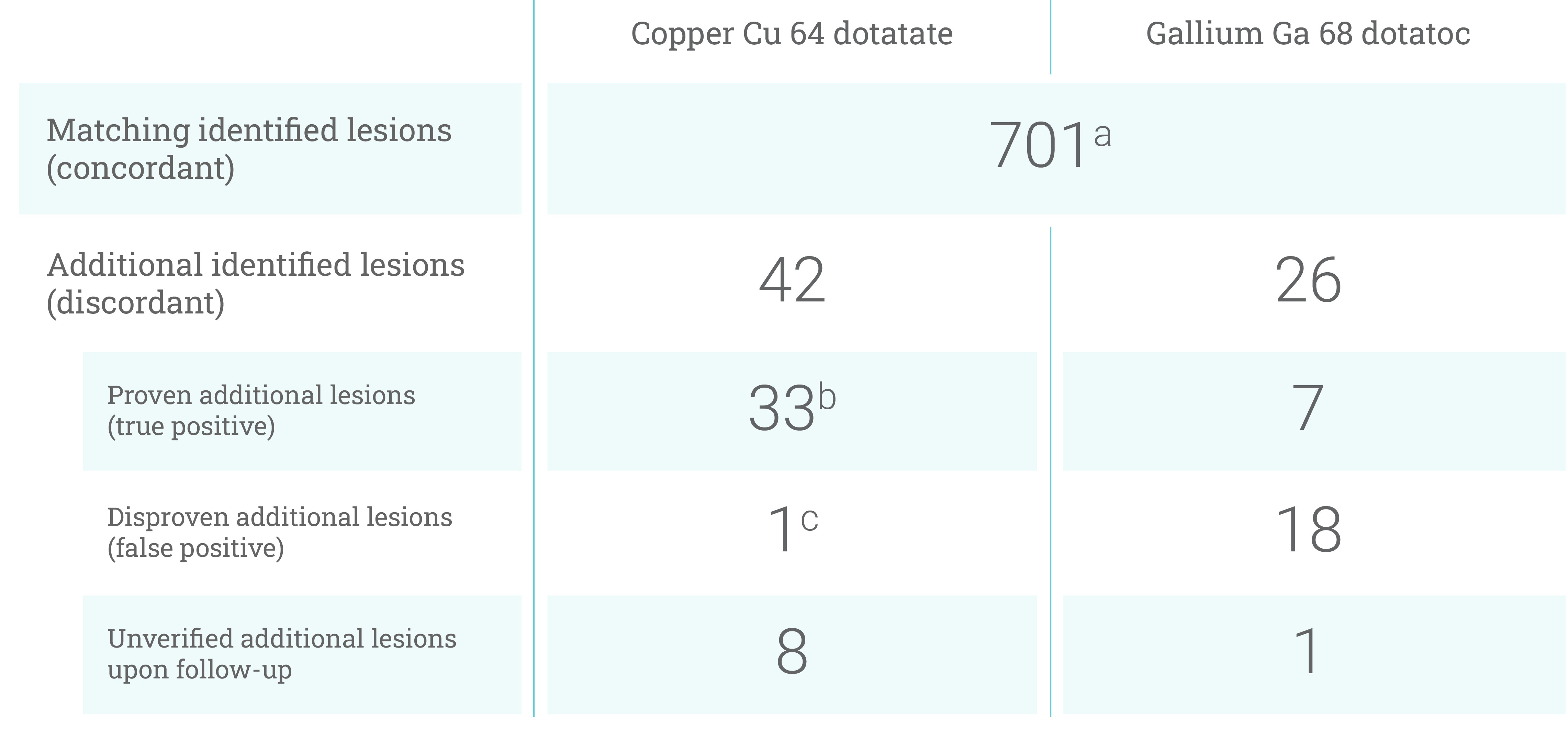
aThe patient-level diagnostic performance was the same for both tracers because they were both able to identify matching lesions in patients where additional lesions were also identified.
bP<.001.
cReported significant but no P value included.
The Johnbeck 2017 authors concluded that “the difference in lesion detection rate found in the current study is presumed to relate to the use of 64Cu instead of 68Ga rather than to differences in peptide.”8
Detectnet’s high accuracy can help you determine a precise diagnosis and treatment plan
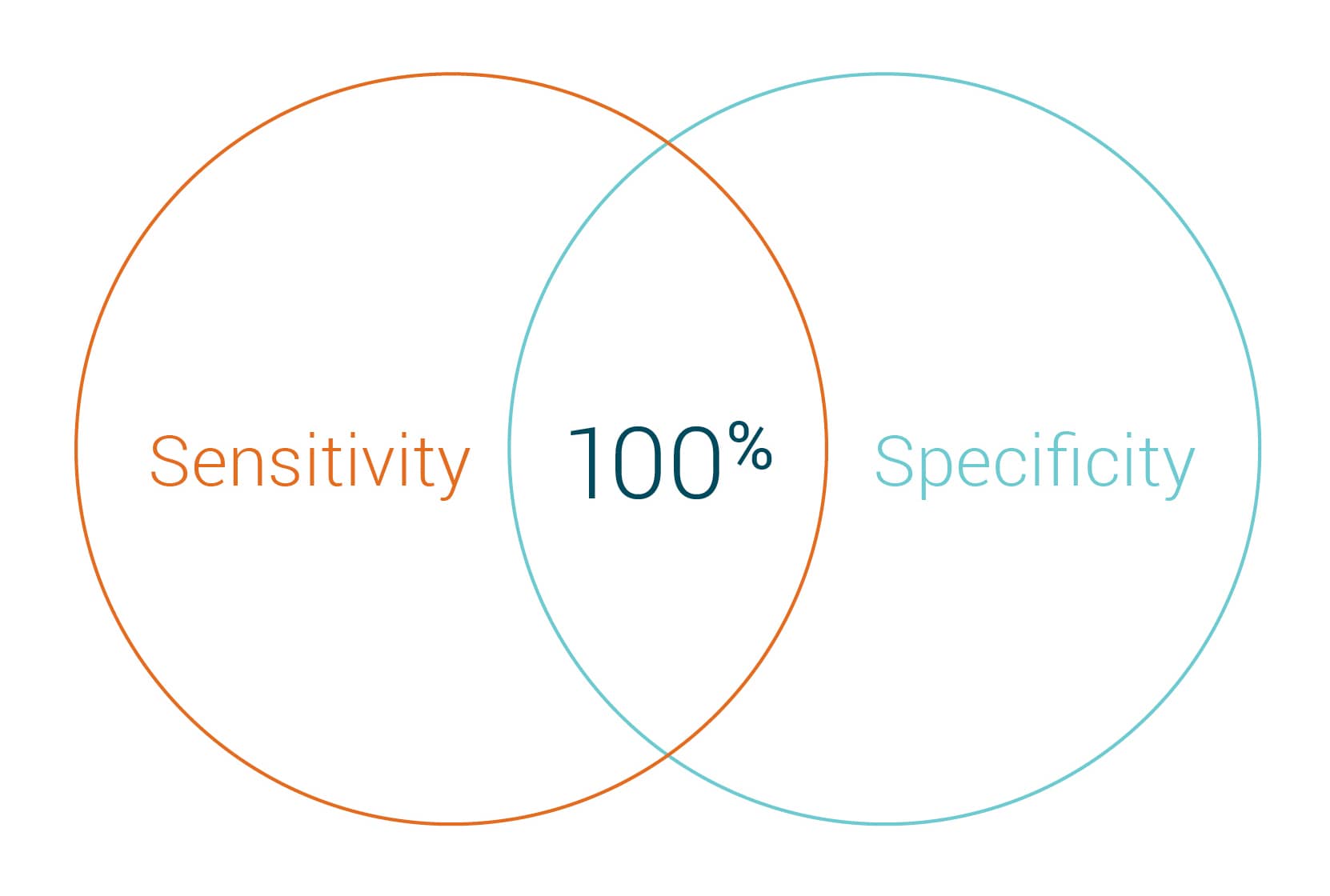
The majority read showed a sensitivity and specificity of 100% in determining localized or metastatic disease.1
Excellent quality images facilitate high inter- and intrareader agreement.1
Access
Flexible scheduling
64Cu’s 12.7-hour half-life enables daily centralized production, wide geographic distribution, and flexible physician and patient scheduling.1,10
Ample dosing available
No kit preparation or costly generator means you get as many doses as you need delivered at once for the entire day.1,2,9
On demand
Deliveries typically arrive by 7 AM, Monday through Friday, with only a few days’ notice, so you can perform scans on your schedule.
IMPORTANT RISK INFORMATION
WARNINGS AND PRECAUTIONS
Radiation Risk
Diagnostic radiopharmaceuticals, including Detectnet, contribute to a patient’s overall long-term cumulative radiation exposure. Long-term cumulative radiation exposure is associated with an increased risk of cancer. Ensure safe handling and preparation procedures to protect patients and health care workers from unintentional radiation exposure. Advise patients to hydrate before and after administration and to void frequently after administration.
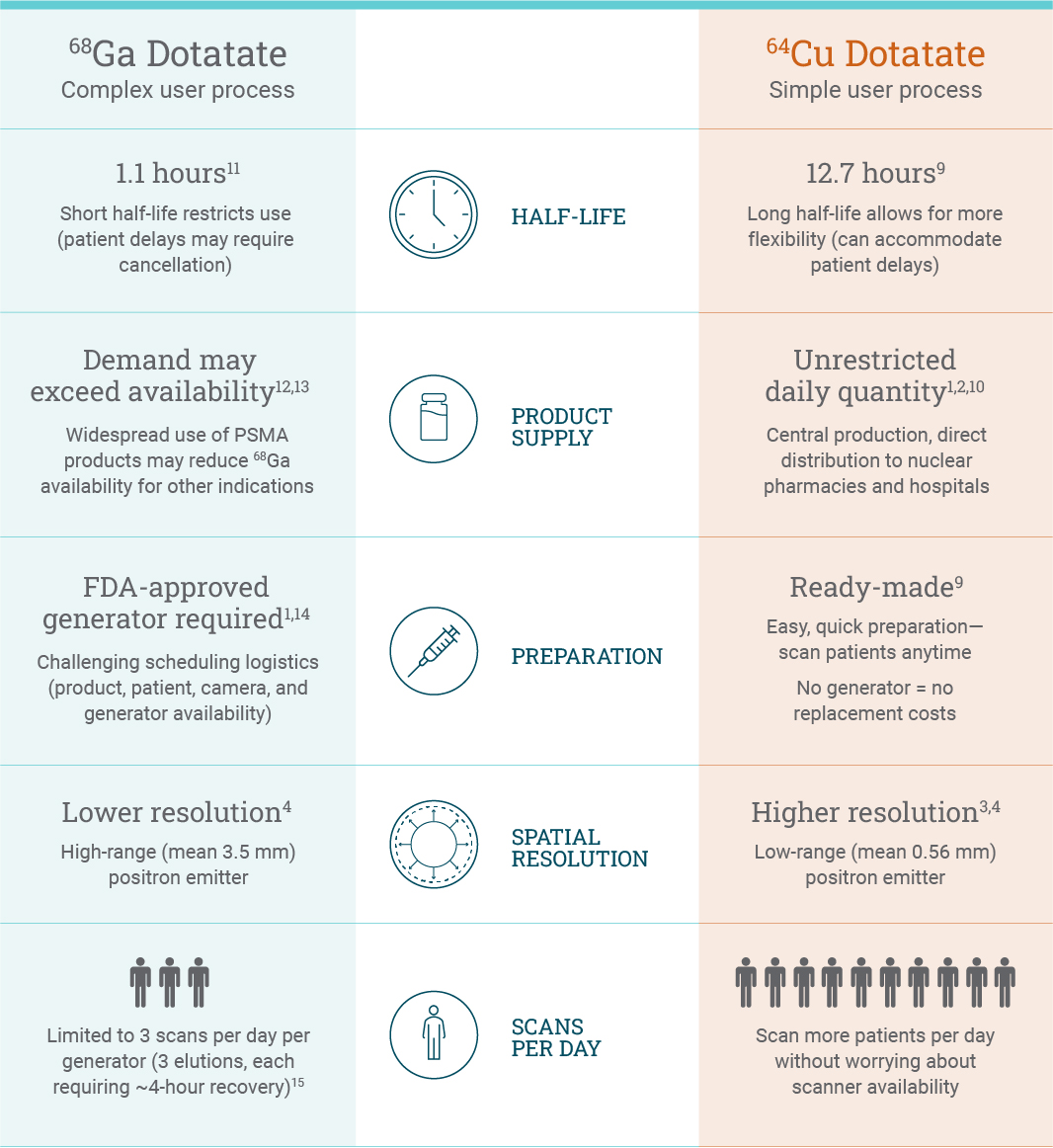
Detectnet makes planning and scheduling easier
Unrestricted quantities
- Order and receive doses whenever you need them
No generator required
- Scan patients anytime
- Save time by easily and quickly preparing doses
- Save money by avoiding annual replacement costs
Streamlined preparation and administration
- Ready-made9
- In adults, the recommended dose for Detectnet is 4 mCi (148 MBq).9 Effective radiation dose in adults:
- Detectnet: 4.74 mSv (4 mCi)9
- Standard of care SPECT product: 26.06 mSv (6 mCi)16
- NETSPOT® (kit for the preparation of gallium Ga 68 dotatate injection): 4.2 mSv (5.4 mCi)11
Refer to the information below for product details and ordering deadlines when placing your order. Please note that the product ships Sunday through Thursday to allow for patient use Monday through Friday. While placing your order, be sure to ask about additional availability of Detectnet.

Indication & Usage
Detectnet is indicated for use with positron emission tomography (PET) for localization of somatostatin receptor positive neuroendocrine tumors (NETs) in adult patients.
Important risk information
WARNINGS AND PRECAUTIONS
Radiation Risk: Diagnostic radiopharmaceuticals, including Detectnet, contribute to a patient’s overall long-term cumulative radiation exposure. Long-term cumulative radiation exposure is associated with an increased risk of cancer. Ensure safe handling and preparation procedures to protect patients and health care workers from unintentional radiation exposure. Advise patients to hydrate before and after administration and to void frequently after administration.
Hypersensitivity Reactions: Hypersensitivity reactions following administration of somatostatin receptor imaging agents predominantly consisted of cutaneous reactions such as rash and pruritus. Reactions reversed either spontaneously or with routine symptomatic management. Less frequently hypersensitivity reactions included angioedema or cases with features of anaphylaxis.
Risk for Image Misinterpretation: The uptake of copper Cu 64 dotatate reflects the level of somatostatin receptor density in NETs, however, uptake can also be seen in a variety of other tumors that also express somatostatin receptors. Increased uptake might also be seen in other non-cancerous pathologic conditions that express somatostatin receptors including thyroid disease or in subacute inflammation, or might occur as a normal physiologic variant (e.g., uncinate process of the pancreas).
A negative scan after the administration of Detectnet in patients who do not have a history of NET disease does not rule out disease.
ADVERSE REACTIONS
In clinical trials, adverse reactions occurred at a rate of < 2% and included nausea, vomiting and flushing. In published trials nausea immediately after injection was observed.
DRUG INTERACTIONS
Somatostatin Analogs: Non-radioactive somatostatin analogs and copper Cu 64 dotatate competitively bind to somatostatin receptors (SSTR2). Image patients just prior to dosing with somatostatin analogs. For patients on long-acting somatostatin analogs, a washout period of 28 days is recommended prior to imaging. For patients on short-acting somatostatin analogs, a washout period of 2 days is recommended prior to imaging.
USE IN SPECIFIC POPULATIONS
Pregnancy: All radiopharmaceuticals, including Detectnet have the potential to cause fetal harm depending on the fetal stage of development and the magnitude of the radiation dose. Advise a pregnant woman of the potential risks of fetal exposure to radiation from administration of Detectnet.
Lactation: Advise a lactating woman to interrupt breastfeeding for 12 hours after Detectnet administration in order to minimize radiation exposure to a breastfed infant.
Pediatric Use: The safety and effectiveness of Detectnet have not been established in pediatric patients.
Geriatric Use: In general, dose selection for an elderly patient should be cautious, usually starting at the low end of the dosing range, reflecting the greater frequency of decreased hepatic, renal, or cardiac function, and of concomitant disease or other drug therapy.
OVERDOSAGE
In the event of a radiation overdose, the absorbed dose to the patient should be reduced where possible by increasing the elimination of the radionuclide from the body by reinforced hydration and frequent bladder voiding. A diuretic might also be considered.
Frequently asked questions
Detectnet (NDC 69945-064-01) is supplied as a sterile, clear, colorless to yellow solution in a 10 mL single-dose vial containing 148 MBq (4 mCi) (37 MBq (1 mCi) per mL) of copper Cu 64 dotatate at calibration date and time. The sealed vial is contained in a shielded (lead) container for radiation protection. The product is shipped in a Type A package. Single Patient Use Vial – Discard Unused Portion.9
Store Detectnet in an upright position within the lead shielding to protect handlers from exposure to radiation. Store Detectnet at controlled room temperature 20°C to 25°C (68°F to 77°F). Do not use and discard Detectnet 2 hours after the calibration date and time.9
The lot number is listed on the label of each vial.
How is this product supplied
Order information
| Description | Qty | Unit | Size | Order # | NDC |
|---|---|---|---|---|---|
| Detectnet | 1 | Each | 148 MBq (4 mCi) |
N064A0 | 69945-064-01 |
To place an order, contact your Curium representative or call customer service at 888-744-1414, Monday through Friday, 7 AM to 5 PM CT.
© 2023 Curium US LLC. Detectnet™, Curium™, and the Curium logo are trademarks of a Curium company. NETSPOT® is a registered trademark of Advanced Accelerator Applications USA, Inc.
References
1 Delpassand ES, Ranganathan D, Wagh N, et al. J Nucl Med. 2020;61(6):890-896. doi:10.2967/jnumed.119.236091.
2 Pfeifer A, Knigge U, Binderup T, et al. J Nucl Med. 2015;56(6):847-854.
3 Jødal L, Le Loirec C, Champion C. Phys Med Biol. 2014;59(23):7419-7434.
4 Conti M, Eriksson L. EJNMMI Physics. 2016;3(1):8.
5 Alva-Sánchez H, Quintana-Bautista C, Martínez-Dávalos A, Ávila-Rodríguez MA, Rodríguez-Villafuerte M. Phys Med Biol. 2016;61(17):6307-6321.
6 Singh S, Granberg D, Wolin E, et al. J Glob Oncol. 2016;3(1):43-53.
7 Yao JC, Hassan M, Phan A, et al. J Clin Oncol. 2008;26(18):3063-3072.
8 Johnbeck CB, Knigge U, Loft A, et al. J Nucl Med. 2017;58(3):451-457.
9 Detectnet. Package insert. Curium US LLC; December 2021.
10 Pfeifer A, Knigge U, Mortensen J, et al. J Nucl Med. 2012;53(8):1207-1215.
11 NETSPOT. Package insert. Gipharma S.r.l.; 10/2023.
12 Tremblay S, Beaudoin JF, Benesty OB, et al. [published online ahead of print, 2022 Jul 29]. J Nucl Med. 2022; jnumed.121.263768.
13 Kumar K. Cancer Biother Radiopharm. 2020;35(3):163-166.
14 Pauwels E, Cleeren F, Bormans G, Deroose CM. Am J Nucl Med Mol Imaging. 2018;8(5):311-331.
15 Velikyan I. Molecules. 2015;20(7):12913-12943.
16 Octreoscan. Package insert. Curium US LLC; February 2022.